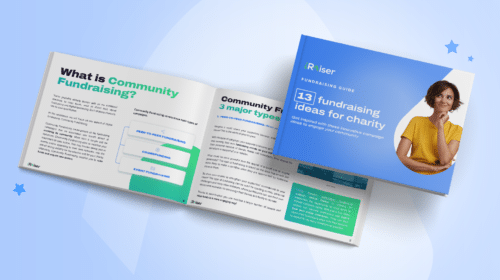With over 17 years experience in the fundraising sector, and a true commitment to charity, our CEO, Antoine Martel sat down with us to answer your questions on fundraising, share his take on the impact of Covid-19 on the charity sector, and give his advice to organisations on how to remain resilient during this time.
Read the interview below

Antoine Martel
President & CEO
iRaiser Group
Q: For those who don’t know you well, tell us a bit about yourself and how you launched iRaiser?
A: I’m 41 years old. I’m a self-made man. I started working in the Internet industry in 1999 in charge of communications for different brands of Lycos, one of the biggest Internet players in Europe.
My first fundraising campaign was in 2003 (17 years ago). I then worked for different fundraising agencies in order to help charities raise money through digital.
In 2008, my friend, the country manager of Facebook France at the time, had a lot of free advertising space available.
He proposed me to offer this advertising space for a charity. We launched a campaign where almost 20,000 people clicked on a button: “I want to make a donation”.
After we ended the campaign, I called the client to celebrate the success of it as I was pretty sure it worked perfectly well, but the call did not go as I expected. The client was not happy and even upset about the low level of donations.
I then assumed something must have gone wrong. I went to their donation form and realized that we had to register, wait for the login & password and fill numerous fields through 8 pages of steps.
From that day on, I told myself, it’s not relevant to spend time, money & resources on a fundraising campaign if the donation form is not easy, quick & secure.
This is how I created iRaiser: to provide easy, quick and secure donation forms and other solutions for fundraising organizations.
Q: Since the Covid-19 outbreak, how do you think the fundraising sector has changed?
A: I’ve noticed 2 changes.
One is linked with Covid-19 and the other, it has been going on for a couple of years now, but has become even more evident with the Covid-19 crisis.
1. For the first time ever, charities can no longer or hardly use channels like Events Fundraising, Face to Face Fundraising, Door to Door Fundraising, Telemarketing or Direct Mail. Digital is now the number one channel for many charities in terms of income and investment.
A few examples: As church masses are no longer possible, churches can no longer collect quest money. They have adapted and moved online in order to survive.
Virtual tours or virtual shows are organized to nourish relationships and raise funds.
Everyone is transforming digitally, and moving their campaigns online.
The manager of The Center of National Monuments (in France) shared with me they have lost almost €50M, due to their temporary closure and cannot receive the funds they usually get from ticketing. They must now find ways to adapt and remain resilient. And as you may understand by now, you achieve this by going digital.
2. Charities are facing competition like never before with personal initiatives popping up through platforms like GoFundme, Facebook, PayPal, Leetchi, LePotCommun, etc. Those initiatives are set up quicker that those created though organizations’ “official” websites. Even if they are a personal initiative, they can be considered by charities as competition. In many cases, what is given to a personal campaign might be seen as a loss of a donation for charities since people’s wallets are not unlimited. People cannot give to everyone. Donors may sometimes have the feeling that their donations will be more efficient through a personal initiative that seem more concrete than the ones of charities.
Q: Do you think the crisis has had a negative or positive impact on the sector?
A: In the short term: the impact has been quite positive. I have never seen before, in my life and career, so many fundraising initiatives all over the world. On our side, at iRaiser, we have never raised so many funds for our clients in such a short period of time. Our clients have received over 800,000 donations in the last 2 months!
I believe that some people (individuals and/or corporate) are donating for the first time. This means charities will have many new donors.
If they are able to build a strong & trusting relationship with those new donors, they might be able to get a second donation, which can eventually lead to them becoming recurring donors.
In the middle & long term: We do not know yet how bad the economy will be impacted by this crisis.
As the level of debts of institutions rise, and some corporations that were used to donating may stop as they may go bankrupt, as some people may lose their jobs or have reduced income, I imagine that some donors (institutions, corporate or individuals) may decrease the amount of their recurring donations, or may not be able to give at all and may just stop.
Now, some other people that have never donated before, or have no philanthropic activity will be inspired to get involved and help the world out of this crisis.
Fundraising will be needed now more than ever before, but fundraisers will need to be better, smarter, and stronger. I believe that it will be very challenging but as many beneficiaries depend on it, fundraisers face a huge responsibility!
Companies: For sure the crisis will have a negative impact on the economy and thus on companies. But we also see a beautiful engagement from corporations who want to use their strengths to support their community. From manufacturing masks, artificial respirators and many other great initiatives. The way companies are reacting today is really interesting and shows a lot of potential for future collaborations. The ones which are really expanding their CSR activities and are doing great now, will be remembered in the future. Long before the crisis, stats already showed that more than 80% of young people from Generation Z only want to work for companies that have a positive impact, so we can easily see how this will be amplified after COVID. This is both an opportunity for companies to reinvent their relationship with the nonprofit sector, and for nonprofits to imagine a deeper involvement with companies. I see a huge opportunity here.
Q: It has been 1 year since the fire of Notre de Dame de Paris, a fundraising phenomenon we all remember. Looking back, do you think there are any lessons to be learned that nonprofits can apply today during the crisis?
A: Be ready. Having a highly secure donation form with the appropriate payment methods, languages, and capability to support heavy traffic can make or break a campaign. PayPal, AmazonPay, ApplePay, GooglePay, and Check or Bank Transfer represent more than 50% of the payment methods used. In the case of Notre Dame, all the countries in the world made a donation (except Somalia and North Korea), and we saw up to fifteen thousand connections per second, and faced more than a hundred attempted computer attacks in a week! Don’t lose donors because your form is not secure, easy to use and scalable.
Be the 1st. Be reactive & opportunistic. 70% of the funds for Notre Dame were collected within 48 hours, so it’s safe to say you cannot miss out on the momentum, and you have to be quick! Prepare your team to be on call, have dedicated budgets, and invest in your SEO, SEM, SMO.
Be proactive. As I mentioned earlier, companies often look for opportunities to help their community and expand their CSR activities. Take advantage of this with matching giving programs, and employee giving initiatives.
Be inspiring. In times of crisis, people long to be a part of a positive story or adventure. Help your donors see what they are a part of how they are helping their community and the world, and inspire them to make a difference.
Be different. All causes are important, but try to stand out from the rest of campaigns that will pop-up. Use your communication, initiatives, and relationship with your donors, to give them even more reasons to keep supporting your organisation.
Q: How does the solidarity we see around the world in reaction to Covid-19 compare to that of Notre Dame?
I do not have the global figures yet, but I believe it will be 10 times bigger.
Notre Dame de Paris raised close to 900 million euros. I believe that charities already raised 9000M€ with 5000M$ only for US.
Q: Do you think organisations not having a direct link to Covid-19 will see a negative impact on their fundraising efforts? How should they approach this crisis?
No matter what your organization is doing, everybody is impacted by this crisis.
Some organisations will be negatively impacted for sure, but they can take action to manage as best they can the situation by being inspiring in the difference they make.
If people are touched, moved and inspired, people will keep donating.
If your organization isn’t on the front line, you can also:
1. Become a “helper brand”: You can bring some help to those that are suffering from quarantine (creating dedicated content for example inspired by your day to day mission). For example, if you’re an Animal oriented NGO, you can help people in quarantine to take care of their animals. You can create content for parents to teach their children about a specific situation or condition in the world.
or
2. “Champion others”: use your voice power to help other brands. Your supporters can understand that as you have nothing to say about Covid, you help others. They will remember this positively.
Q: Do you have any advice for nonprofits to remain resilient during the global crisis?
A: Yes! Create empathy with your audience and your donors, and be inspiring with the difference you are making. People love to be part of a positive story and adventure. They will be touched by how you react during this time, and will remember it.
Don’t forget to be thankful. Your supporters need to be acknowledged for their efforts and the support they give you. Being thankful can help you strengthen even more your relationship.
Q: Which data do you think is useful to ask in a donation form, and which is better to avoid?
A: I would really try to ask the minimum of your donors, and allow them to use advanced payment methods like ApplePay, GooglePay, AmazonPay or PayPal Express Checkout. These payment methods simplify the donation process into a 1-click step, reducing time, improving the user experience, and thus increasing conversion rates.
These types payment methods combined could represent up to 50% of all online donations. They are an essential element of online forms.
You could consider asking the rest of the information in the thank you page, once you have secured the donation.
Q: What can organisations do to drive traffic to their payment platform? And what tips can you give them to apply easy cookies, tags, algorithms, widgets to increase the average donation?
A: In order to drive traffic:
– Improve your SEO (search engine optimization) by working on the 3 pillars: Content, Technicals and Netlinking (make your website SEO friendly with a responsive site, ssl certificate, fast page loading, sitemap, robots.txt, etc)
– SEM (search engine marketing) is one of the most effective ways to drive traffic. Make sure to use the right keywords and improve your Quality Score.
– Work on a proper SMO (social media optimization) strategy. Create interesting online content, ranging from well-written text to eye-catching photos or videos that encourage and entice supporters to engage with your brand and cause. Be present on the different social platforms (Instagram, Facebook, Linkedin, Twitter, etc) and make sure to plan content accordingly.
– Use segmentation tools to email your database with relevant & personalized content.
– Work on Press Releases and interviews to get your story out there.
– Partner up with corporates to reach new supporters & donors.
Q: My last question is what is the biggest mistake you see that impacts the conversion rate of donations.
A: I always insist, forms often have too many fields to fill, too many pages, too many steps. Remember if you can see the finish line at the end of the marathon, you are very likely to cross it. Same goes for donations forms. Keep it as simple and quick as possible.
I see sometimes a lack of payment methods, and languages available for donors. This can limit the reach of your campaign, and is certainly a way to lose a donation if the donor cannot find their local or payment method of choice.
Just remember to keep your donor’s experience in mind. If their experience in giving to your charity is memorable, user-friendly, secure, and rewarding, they are very likely to gain trust in your organisation and give to you again.
Click on the link below to watch the full Q&A webinar interview with Antoine!





